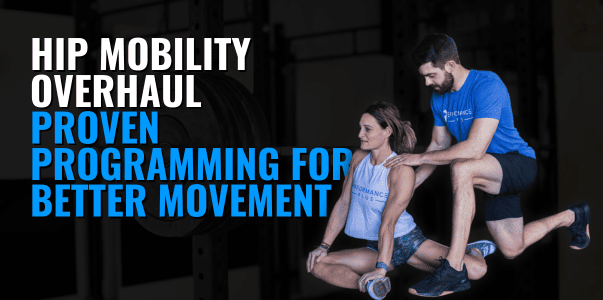If you are looking to improve your hip mobility for improved performance or less pain, then using different banded hip mobilization techniques can be incredibly helpful. There are a number of different ways we can set a band up to help with opening up different directions of motion.
Choosing the best mobilization for your specific needs is key to seeing the most rapid changes in the movements you care about. To do that I would recommend following these two steps:
- Download our Ultimate Mobility Checklist and run through the various mobility assessments shown. This document will help you better identify the exact mobility pieces you should prioritize. Far too often, athletes waste time working on the wrong areas. Don’t do that. Take the time to be precise with your mobility work.
- Follow the test-retest model. Once you have identified what you need to work on, test the different mobilizations below for that area. After performing one mobilization, retest your mobility. Find the drills that create the greatest change and focus on those.
Banded Hip Mobilizations
Goal: Improving Hip Flexion
Lack of hip flexion impacts an athlete’s ability to perform a number of different movements, most commonly squatting. When addressing hip flexion deficits I’ll commonly start by addressing hip internal rotation and posterior capsule mobility which will often improve flexion. But for some athletes, specifically getting after flexion is needed. These three are my go-to banded hip mobilization techniques.
Quadruped rocks with band mobilizations are probably my starting point. While on hands and knees, we have a resistance band high up the thigh. The athlete will maintain a flat back as they rock back and forth into increasing levels of hip flexion.
Test both the lateral distraction and the inferior mobilization and see if one does a better job reducing pain or improving motion. Focus on the one that does a better job changing symptoms.
We can increase the mobilization specificity with the following two mobilizations. I demonstrate both of these below with my foot on both as I rock forward and back. But these can be performed with other functional movements such as squats and lunges.
Hip Mobs for Hip Internal Rotation
Hip internal rotation mobility is very often ignored by individuals working on hip mobility. While some athletes will be limited due to the structures of the bones in the hip, many others will see drastic changes in functional movements by opening up their hip IR.
This lateral distraction with active movement is a great way to being improving hip internal rotation.
If our goal is to improve hip internal rotation with the hope of it unlocking hip flexion motion, then this quadruped rock back is my go-to. The resistance band pulls laterally. Hook one leg outside of the weight to keep the hip internally rotated. Then rock back with a flat back to increase the stretch.
Posterior Hip Mobilizations
Posterior hip mobilizations do a great job of improving hip rotation and flexion range of motion. Both videos below show the same stretch but with the band mobilization inferiorly or laterally directed. As with the above, test both. The re-test the movement you are trying to improve (your squat, lunge, etc). Then focus your mobility work on the variation that creates greater changes.
Anterior Mobs
For athletes will limited hip extension I use two different mobs. The first, we’ve all probably seen where we perform a hip flexor stretch with the band anteriorly mobilizing the joint.
The second stretch is less commonly utilized. This mobilization I commonly use in individuals with a limited FABER test who have stiff rather than hypermobile hips. Breaking down the complexities behind the clinical reasoning utilized for FABER stiffness vs hypermobility is too complex for this article. But I couldn’t leave this one out because it has helped many athletes I have worked with.
General Hip Mobilization Typically Utilized for Pain
The final banded hip mobilization I’ll share is simple long axis distraction. This one I tend to use in patients dealing with higher levels of pain. The distraction work quite often helps to get people out of the initial stages of rehab that are often very pain-limited.
Want more hip mobility help? Check out our Hip Mobility Overhaul plan inside of Performance Plus Programming!







